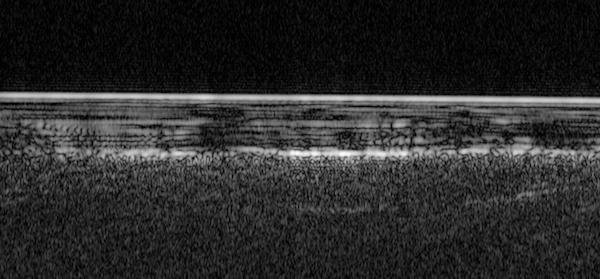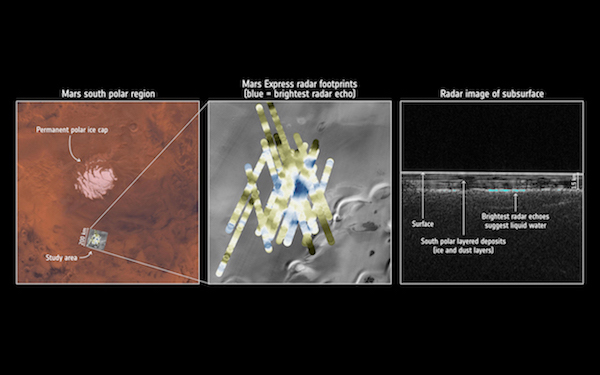Mars Express detects liquid water hidden under planet's south pole
25 July 2018
Radar data collected by ESA's Mars Express point to a pond of liquid water buried under layers of ice and dust in the south polar region of Mars. |
| Radar detection of water under the south pole of Mars. Credit: ESA/NASA/JPL/ASI/Univ. Rome |
Evidence for the Red Planet's watery past is prevalent across its surface in the form of vast dried-out river valley networks and gigantic outflow channels clearly imaged by orbiting spacecraft. Orbiters, together with landers and rovers exploring the martian surface, also discovered minerals that can only form in the presence of liquid water.
But the climate has changed significantly over the course of the planet's 4.6 billion year history and liquid water cannot exist on the surface today, so scientists are looking underground. Early results from the 15-year old Mars Express spacecraft already found that water-ice exists at the planet's poles and is also buried in layers interspersed with dust.
The presence of liquid water at the base of the polar ice caps has long been suspected; after all, from studies on Earth, it is well known that the melting point of water decreases under the pressure of an overlying glacier. Moreover, the presence of salts on Mars could further reduce the melting point of water and keep the water liquid even at below-freezing temperatures.
But until now evidence from the Mars Advanced Radar for Subsurface and Ionosphere Sounding instrument, MARSIS, the first radar sounder ever to orbit another planet, remained inconclusive.
It has taken the persistence of scientists working with this subsurface-probing instrument to develop new techniques in order to collect as much high-resolution data as possible to confirm their exciting conclusion.
Ground-penetrating radar uses the method of sending radar pulses towards the surface and timing how long it takes for them to be reflected back to the spacecraft, and with what strength. The properties of the material that lies between influences the returned signal, which can be used to map the subsurface topography.
The radar investigation shows that south polar region of Mars is made of many layers of ice and dust down to a depth of about 1.5 km in the 200 km-wide area analysed in this study. A particularly bright radar reflection underneath the layered deposits is identified within a 20 km-wide zone.
Analysing the properties of the reflected radar signals and considering the composition of the layered deposits and expected temperature profile below the surface, the scientists interpret the bright feature as an interface between the ice and a stable body of liquid water, which could be laden with salty, saturated sediments. For MARSIS to be able to detect such a patch of water, it would need to be at least several tens of centimetres thick.
"This subsurface anomaly on Mars has radar properties matching water or water-rich sediments," says Roberto Orosei, principal investigator of the MARSIS experiment and lead author of the paper published in the journal Science today.
"This is just one small study area; it is an exciting prospect to think there could be more of these underground pockets of water elsewhere, yet to be discovered."
"We'd seen hints of interesting subsurface features for years but we couldn't reproduce the result from orbit to orbit, because the sampling rates and resolution of our data was previously too low," adds Andrea Cicchetti, MARSIS operations manager and a co-author on the new paper.
"We had to come up with a new operating mode to bypass some onboard processing and trigger a higher sampling rate and thus improve the resolution of the footprint of our dataset: now we see things that simply were not possible before."
The finding is somewhat reminiscent of Lake Vostok, discovered some 4 km below the ice in Antarctica on Earth. Some forms of microbial life are known to thrive in Earth's subglacial environments, but could underground pockets of salty, sediment-rich liquid water on Mars also provide a suitable habitat, either now or in the past? Whether life has ever existed on Mars remains an open question, and is one that Mars missions, including the current European-Russian ExoMars orbiter and future rover, will continue to explore.
"The long duration of Mars Express, and the exhausting effort made by the radar team to overcome many analytical challenges, enabled this much-awaited result, demonstrating that the mission and its payload still have a great science potential," says Dmitri Titov, ESA's Mars Express project scientist.
"This thrilling discovery is a highlight for planetary science and will contribute to our understanding of the evolution of Mars, the history of water on our neighbour planet and its habitability."
Mars Express launched 2 June 2003 and celebrates 15 years in orbit on 25 December this year.
Notes for editors
"Radar evidence of subglacial liquid water on Mars" by R. Orosei et al is published in the journal Science.
The MARSIS instrument was funded by the Italian Space Agency (ASI) and NASA and developed by the University of Rome, Italy, in partnership with NASA's Jet Propulsion Laboratory.
For more information please contact:
Roberto Orosei
MARSIS Principal Investigator
Istituto Nazionale di Astrofisica, Bologna, Italy
Email: roberto.orosei![]() inaf.it
inaf.it
Andrea Cicchetti
MARSIS Operations Manager
Istituto Nazionale di Astrofisica, Roma, Italy
Email: andrea.cicchetti![]() iaps.inaf.it
iaps.inaf.it
Dmitri Titov
ESA Mars Express Project Scientist
Email: dmitri.titov![]() esa.int
esa.int
Markus Bauer
ESA Science Communication Officer
Tel: +31 71 565 6799
Mob: +31 61 594 3 954
Email: markus.bauer![]() esa.int
esa.int



